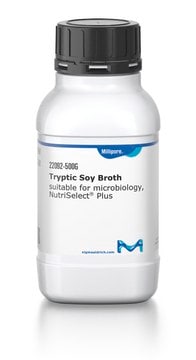1.05450
GranuCult® Nutrient agar
ISO 6579, ISO 10273, ISO 19250, ISO 21528, APHA, suitable for microbiology
About This Item
Recommended Products
Agency
APHA
ISO 10273
ISO 19250
ISO 21528
ISO 6579
Quality Level
form
medium granules (dehydrated (DCM))
manufacturer/tradename
GranuCult®
technique(s)
microbiological culture: suitable
pH
7.0 (37 °C, 20 g/L in H2O, after autoclaving)
solubility
20 g/L
bulk density
600 kg/m3
application(s)
food and beverages
microbiology
storage temp.
15-25°C
suitability
heterotrophic bacteria
General description
Application
Analysis Note
Appearance (colour): yellowish-brown
pH-value (25 °C): 6.8 - 7.2
Solidification behaviour (2 hrs., 45 °C): liquid
Growth promotion test in accordance with the current version of DIN EN ISO 11133.
Inoculum on reference medium (Escherichia coli ATCC 8739 (WDCM 00012)):
Inoculum on reference medium (Escherichia coli ATCC 25922 (WDCM 00013)):
Inoculum on reference medium (Salmonella typhimurium ATCC 14028 (WDCM 00031)):
Inoculum on reference medium (Salmonella enteritidis ATCC 13076 (WDCM 00030)):
Inoculum on reference medium (Yersinia enterocolitica ATCC 9610 (WDCM 00038)):
Inoculum on reference medium (Yersinia enterocolitica ATCC 23715 (WDCM 00160)):
Inoculum on reference medium (Staphylococcus aureus ATCC 25923 (WDCM 00034)):
Colony count (Escherichia coli ATCC 8739 (WDCM 00012)):
Colony count (Escherichia coli ATCC 25922 (WDCM 00013)):
Colony count (Salmonella typhimurium ATCC 14028 (WDCM 00031)):
Colony count (Salmonella enteritidis ATCC 13076 (WDCM 00030)):
Colony count (Yersinia enterocolitica ATCC 9610 (WDCM 00038)):
Colony count (Yersinia enterocolitica ATCC 23715 (WDCM 00160)):
Colony count (Staphylococcus aureus ATCC 25923 (WDCM 00034)):
Recovery on test medium (Escherichia coli ATCC 8739 (WDCM 00012)): ≥ 70 %
Recovery on test medium (Escherichia coli ATCC 25922 (WDCM 00013)): ≥ 70 %
Recovery on test medium (Salmonella typhimurium ATCC 14028 (WDCM 00031)): ≥ 70 %
Recovery on test medium (Salmonella enteritidis ATCC 13076 (WDCM 00030)): ≥ 70 %
Recovery on test medium (Yersinia enterocolitica ATCC 9610 (WDCM 00038)): ≥ 70 %
Recovery on test medium (Yersinia enterocolitica ATCC 23715 (WDCM 00160)): ≥ 70 %
Recovery (Staphylococcus aureus ATCC 25923 (WDCM00034)): ≥ 70 %
Incubation:
24 ± 2 at 37 ± 1 °C aerobic
Yersinia 24 ± 2 hours at 30 ± 1 °C aerobic
A recovery rate of 70 % is equivalent to a productivity value of 0.7.
The indicated colony counts result from the sum of a triple determination.
Reference media: Tryptic Soy Agar
Footnote
The designations basic, plus, or prime are added to indicate the quality control level, from basic quality control to standard QC plus to prime for full regulatory compliance.
Legal Information
Storage Class Code
11 - Combustible Solids
WGK
WGK 3
Certificates of Analysis (COA)
Search for Certificates of Analysis (COA) by entering the products Lot/Batch Number. Lot and Batch Numbers can be found on a product’s label following the words ‘Lot’ or ‘Batch’.
Already Own This Product?
Find documentation for the products that you have recently purchased in the Document Library.
Customers Also Viewed
Protocols
The International Organization for Standardization (ISO) published the revised EN ISO 21528-1 and EN ISO 21528-2 standards in 2017.
EN ISO 6579-1 standard specifies detection of Salmonella spp. in human consumption, animal feed, and environmental samples.
EN ISO 6579-1 standard specifies detection of Salmonella spp. in human consumption, animal feed, and environmental samples.
EN ISO 6579-1 standard specifies detection of Salmonella spp. in human consumption, animal feed, and environmental samples.
Our team of scientists has experience in all areas of research including Life Science, Material Science, Chemical Synthesis, Chromatography, Analytical and many others.
Contact Technical Service






